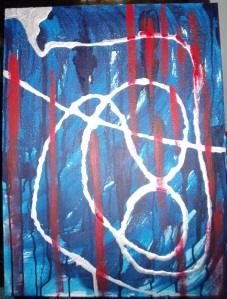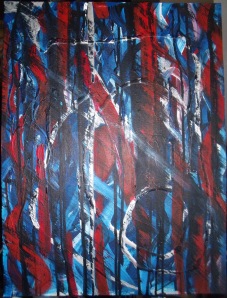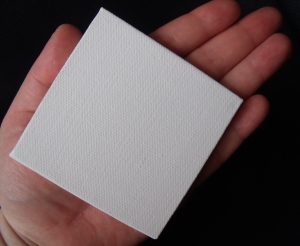I would like to share a personal experience I recently had while painting. Those of you who are not into art, read it for the metaphor. This is about a whole lot more than just painting.
I had been working on a painting over the weekend, to express some strong emotions about the following week. Monday was going to be a challenge for me, and I really wanted to finish the painting before I saw my analyst on Monday afternoon. Monday’s session would mark a kind of anniversary that was extremely painful for me, an anniversary I wished weren’t happening. I don’t usually make time restrictions on myself when I paint – I like to give myself time to feel into the work and let it develop as it will, in its own time. However, this time, the time pressure was part of what I was expressing, which is why the time restriction felt right. (For the sake of privacy, I am not sharing what the anniversary was, or the title of the painting, but I feel that this will not take away from the experience I am sharing.)

I should tell you a little bit about how I paint. I begin when I either have a feeling I want to express, or the beginning of an image comes to mind. Sometimes it’s something as simple as wanting to make a stroke on the canvas in a particular way, with a specific brush or implement, or in a particular color. I paint in the abstract and never know what the finished product will look like. I just know what it doesn’t look like. I choose colors and textures I am drawn to in the moment as I paint, and in a way, “relate” to the canvas and to what’s already on it. It’s entirely based on how it feels. And I keep going, adding and changing things until I feel a shift inside me when I look at the painting. At some point – be it in the space of hours, days, or weeks – eventually something always “clicks” and the painting feels complete. It can be frustrating, because I never know when this shift would happen, but I have learned to enjoy the process and see what develops. Often (but not always), I take progress photos while I work – such as before making major changes. A mid-way photo of the painting I’m describing is to the right. (You can click the image for a larger view.)
The colors I have been most recently drawn to are navy, red, black, and white. Several of my recent paintings have had this color palette, as did this one. As I worked on it, for quite a while I didn’t like how it felt. It felt too similar to my previous paintings. And while even Picasso had a period when he painted in similar tones for some time, the painting just didn’t feel right. And time was pressing. Something needed to shift in the painting to finally express what I was feeling, but it kept feeling too similar – almost too “polite”. Knowing that I would show the painting to my analyst and to other people has somehow kept me constricted. I was afraid to paint something too gruesome, too painful to look at. I was ex pressing painful states, and yet I didn’t want them to be too painful to those who would look at it. It was a struggle. Feeling frustrated and saddened by this, I added more navy-colored downward “tears” to the canvas, in the hopes of making the shift I needed. It felt a little better, but still not quite right.
Suddenly, I noticed that I actually felt a similar kind of pressure that I often feel in the last 10 minutes of a session with my analyst. It is the urge to be authentic and express what really matters before my time is up and I have to get up and leave. As the morning inched toward the afternoon and I had less and less time remaining until this self-imposed deadline, I felt the urge to “put it all out there” without beating around the bush. Not knowing how to make the painting make the needed shift, I took a thick, coarse, dry brush, and began to make diagonal swipes across those navy “tears”. It felt like an enormous, desperate risk. I felt like I might deface the entire painting and possibly ruin the work of many, many hours. However, the internal pressure was too great, and the dissatisfaction with the previously too-familiar and too-polite painting was just too painful. I decided that I would rather ruin the painting than settle for something that felt wrong. I had both nothing and everything to lose. It’s only paint on a canvas, but sometimes the feeling really is this intense.
 I began to make these diagonal strokes across the entire painting. It was both frightening and liberating. For a few moments, and in the safety of an 18” x 24” space, I was literally letting it all be out there. I wasn’t being “polite”. I wasn’t worried about overwhelming someone with my intensity. I just let my feeling go forth. So you won’t be surprised to learn that with such authentic expression, the painting transformed into what finally felt real. I let out an intense gasp when I suddenly saw the entire painting differently. My “click” finally happened. The texture changed, as did the depth and dimension of the entire work. It almost felt like it grew up from a more childlike, repetitive, familiarly-restricted feeling to a more mature, more authentic expression.
I began to make these diagonal strokes across the entire painting. It was both frightening and liberating. For a few moments, and in the safety of an 18” x 24” space, I was literally letting it all be out there. I wasn’t being “polite”. I wasn’t worried about overwhelming someone with my intensity. I just let my feeling go forth. So you won’t be surprised to learn that with such authentic expression, the painting transformed into what finally felt real. I let out an intense gasp when I suddenly saw the entire painting differently. My “click” finally happened. The texture changed, as did the depth and dimension of the entire work. It almost felt like it grew up from a more childlike, repetitive, familiarly-restricted feeling to a more mature, more authentic expression.
I am hopeful that the metaphor is self-evident, but for the sake of completeness I will re-state it. The familiarly-restricted, “polite” painting was like being familiarly inhibited and polite with another person, holding back my truth in fear of being too much, causing pain, and being too aggressive in my self-expression. Making those diagonal strokes felt like a risk, it went against all of the above – both literally and metaphorically. Under the pressure of time – the awareness of which was painfully present for me – I wanted to be as authentic as possible. While this was a special moment for me – a breakthrough – the insight is (ironically) quite timeless: risking it all and putting myself out there was so much more worthwhile than hiding behind a familiarly inhibited way of being.
(If you would like to see more of my art, please visit my Artwork page — I have recently updated it with more of my pieces.)



